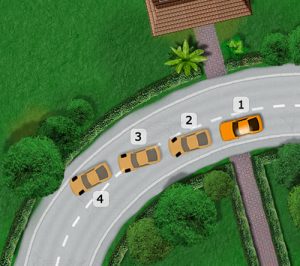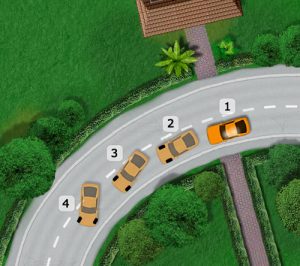It is of course best to avoid a loss of control in the first place as the cause of a skidding car is by far, the result of driver error. So, what causes a car to skid?
Main Causes of a Skid
A skid is the result of a loss of traction between the vehicle tyres and the road surface. This is usually because the driver has:
- Accelerated too harshly
- Braked too harshly
- Used excessive or abrupt steering
- Entered a hazard, such as a corner at too higher speed
Though a skid if often the result of driver error, there are of course exceptions where a mechanical, electrical or other defect such as a tyre blowout can cause a skid.
What Types of Skid are There?
If your vehicle is involved in a skid, you’ll encounter either:
- Front wheel skid – where the front wheels lose traction
- Rear wheel skid – where the rear wheels lose traction
- Four wheel skid – where all four wheels lose traction
Certain vehicles have a greater chance of developing particular skids. A rear wheel drive car has a greater chance of developing a rear wheel skid for example.
Symptoms That Your Car Is Losing Control
Fundamentally, the most important aspect of controlling a skid is to acknowledge that your vehicle has in fact lost control and to act on this assertively and quickly. As obvious as this might sound, to acknowledge that a car is losing or has lost control isn’t clearly perceived by some drivers at early onset.
The quicker you react, the better the chance of you regaining control. Generally, if your car feels unusual and doesn’t react as it normally does, it could be a symptom of a loss of control and may include one or more of these issues:
- Light, unresponsive steering
- Steering does not result in vehicle moving in intended direction
- Accelerating does not result in forward motion
- Car feels as though it’s moving sideways
- Braking does not slow vehicle down
How to Control a Skidding Car
How you should attempt to control a skidding car depends on the types of skid that you’re experiencing as detailed below. Understanding the symptoms, your location (on a bend in the road for example) and the road condition (road is wet or icy for example), will enable you to react and deal with the skid in a responsive manner.
Front Wheel Skid
What is a front wheel skid?
A front wheel skid (or understeer) is where the driver steers, but the car does not respond in the manner expected. A common example can be seen in diagram ‘Front Wheel Skid’, the driver is taking a left corner, turns the steering wheel to the left but the car does not respond and continues straight ahead.

How does a front wheel skid occur?
The front wheels have lost traction with the road surface due to either driving too fast for the tyres to retain grip This can be simply due to speed or a combination of speed and weather conditions such as a wet road, or sharp, sudden braking whilst entering a corner can cause a front wheel skid.
How to control a front wheel skid
- You turn the steering wheel and become aware that your car is not responding to a change in direction
- Come off the brakes and accelerator and continue to steer in the direction you intend on taking
- If your car still has not regained traction, reduce some of the steering to help the front tyres regain traction and give the brake a quick, reasonably firm press
- By giving the brakes a brief jab will shift the weight of your vehicle to the front, which should regain traction, then begin again to steer in your intended direction
Rear Wheel Skid
What is a rear wheel skid?
A rear wheel skid (or oversteer) is where the rear of the vehicle swings out to either the left or right. Essentially the rear is trying to overtake the front. A typical example can be seen in the diagram ‘Rear Wheel Skid’, where the driver is attempting a left corner with the rear of the car swinging out to the drivers right side.

How does a rear wheel skid occur?
Reasons for a rear wheel skid are similar to that of a front wheel skid – entering a corner too fast, sharp braking or accelerating. Again bad weather conditions can induce or exacerbate a situation. A car skidding around a corner where the rear loses traction is often attributed to rear wheel drive cars, where the driver has applied power at an inappropriate time.
HOW TO CONTROL A Rear WHEEL SKID
- You turn into a corner and become aware that the rear is losing traction and you begin to face the wrong direction
- Come off the brakes and accelerator and continue to look and steer in the direction you intend on taking. Essentially steer in the same direction that the back of the vehicle is sliding. This is often referred to ‘steering into the skid’ – see below.
- It may be tempting to over-steer in a means to compensate, but this must be avoided as this may cause the vehicle rear to skid in the opposite direction
- If you are confident at controlling your vehicle, a little pressure on the accelerator will put increased weight onto the rear of the vehicle which can aid in gaining traction, though this should only be attempted by those that have competent vehicle control skills
Steering into the Skid
Steering into the skid means that if the rear of your car is skidding to the right, then steer to the right and if the rear skids to the left, steer to the left. The most important thing to do is to look in the direction of where you originally intended to go, which is down the road. By doing this, you’ll naturally steer in that direction and therefore ‘steer into the skid’.
Four Wheel Skid
Within the EU, all cars must have anti-lock braking systems (ABS) fitted since the mid 1980’s and as such, it is highly unlikely that a four wheel skid will occur. An example pre-ABS skid would be a driver braking hard to avoid a hazard, resulting in all four wheels locking up. If you happen to be driving a vehicle without ABS or your vehicle has an ABS fault and find yourself emergency braking with all wheels locking, remove your foot from the brakes and begin firmly (but avoid stomping on the brake) pumping the pedal rhythmically.
This is called cadence braking and essentially uses the same technique as ABS by preventing the wheels from locking. The main benefit of this is that you can steer away from the hazard, unlike locked wheels which do not allow you to steer.
Avoiding a Skid
Sometimes an emergency might happen which results in a loss of control and a skid. Often though, it is driver error where it could have been avoided. The best way to avoid a skid is to:
- Ensure your tyres have at least the legal tread depth and are in good general condition. See tyre legal limit check.
- Ensure your tyres are running at the correct pressure and that if you are carrying a heavy load that you adjust tyre pressures accordingly
- Adjust the speed of your vehicle appropriately before entering a corner
- Avoid braking on a corner
- Reduce speed, particularly in wet and icy conditions. See 2 second rule.
- Read the road ahead and plan in good time. See anticipation and planning.
